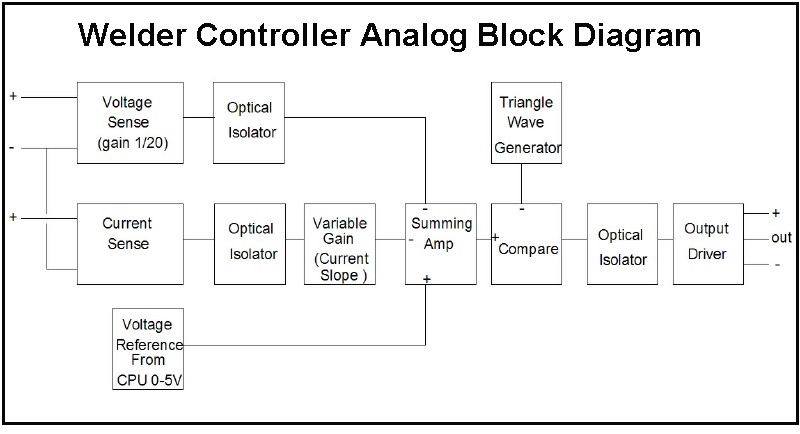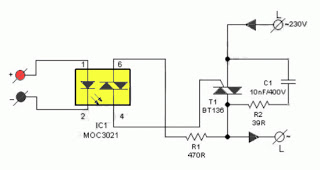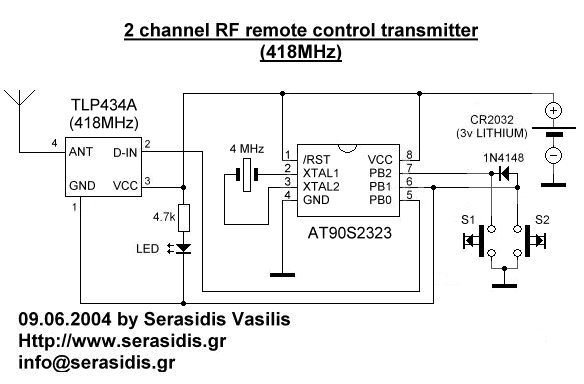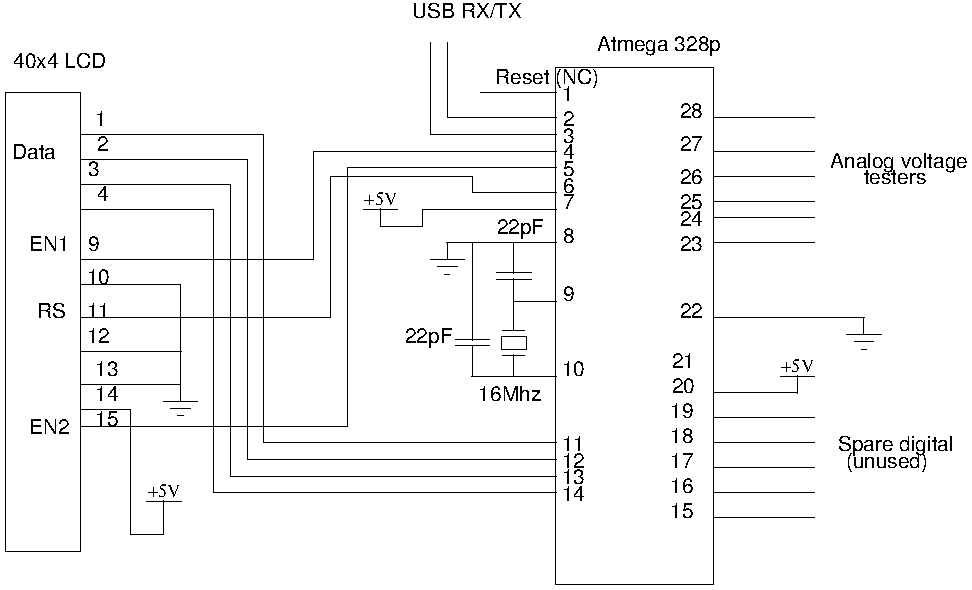
DIY Welder Control Board

The first board is digitally controlled, while the actual welding current is analog. This design enables real-time operation without requiring the CPU to process the voltage or current. A block diagram illustrates its function: it operates as a switching power supply controller. The CPU generates a 0 to 5-volt reference that corresponds to a 0-100V welding voltage. The voltage sense amplifier has a gain of 1/20, meaning that a 0-100V weld voltage will yield a 0-5V output signal. This signal is directed to a summing amplifier that produces a difference signal, which is then sent to a comparator. The comparator receives a 20kHz triangle wave as input. It outputs a PWM signal that varies according to the difference between the desired voltage and the actual voltage. This PWM signal is transmitted to the output driver for field current control. The output stage employs MOSFETs to enhance efficiency. For MIG welding, this entire setup is utilized. For Arc and TIG welding, the voltage must decrease with increasing current. The current sense input is also routed to the summing amplifier, where a variable gain allows for programmable current slope. For instance, if the voltage is set to 40V and the current sense is programmed to a slope of 0.3 volts per amp, at approximately 50 amps, the current sense will output an equivalent of 15 volts, causing the circuit to reduce the output voltage to 25V. At 100 amps, the output voltage will further drop to 10V. All inputs and outputs are optically isolated for safety, protecting against spikes and enabling the output to drive the field or saturation current from any power source. A small switching power supply generates three isolated power supplies for the input and output circuitry. The CPU can adjust the variable gain through an electronic potentiometer. The voltage reference is derived from a PWM output of the CPU, which is processed through a low-pass filter to produce a 0-5V signal. The CPU also monitors the voltage and current sense signals for display output. The "Simplified" board removes the isolators, linking the control circuits directly to the output of the alternator, thereby reducing component count. The front panel includes controls for the voltage reference and variable gain, and the design is specifically tailored to drive an alternator.
The circuit operates as a sophisticated welding control system, integrating digital and analog components to ensure precise voltage and current management during welding processes. The switching power supply controller forms the core of the design, utilizing a microcontroller to generate a reference voltage that facilitates real-time feedback and adjustments. The voltage sense amplifier, with its specific gain setting, ensures that the high voltage levels used in welding are accurately represented at a lower, manageable scale.
The summing amplifier plays a crucial role in comparing the desired welding voltage with the actual voltage, generating a differential signal that is essential for maintaining the desired performance. The comparator, driven by a triangle wave, modulates the output through PWM, allowing for dynamic adjustments in response to varying welding conditions. This PWM output is critical for controlling the MOSFETs in the output stage, which are selected for their efficiency in handling the high currents involved in welding applications.
In addition to the primary MIG welding function, the circuit is designed to adapt to Arc and TIG welding by incorporating a current sensing mechanism that modifies the output voltage in correlation with the current draw. This feature is particularly important in applications where maintaining a consistent arc is vital for quality welds. The variable gain setting allows for customization of the response characteristics, enabling the system to cater to different welding materials and techniques.
Optical isolation is employed throughout the design to ensure safety and reliability, protecting sensitive components from electrical noise and voltage spikes that can occur during welding operations. The inclusion of isolated power supplies further enhances the robustness of the system, ensuring stable operation under various conditions.
The user interface, consisting of front panel controls for voltage reference and variable gain, provides operators with intuitive access to adjust settings as needed. The simplified board version streamlines the design, reducing complexity while maintaining essential functionality, thereby making the system more accessible and cost-effective for users focused on alternator-driven welding applications. Overall, this circuit exemplifies an advanced approach to welding control, combining precision, efficiency, and adaptability.The first board was digitally controlled but the actual welding current is analog. This allows the board to operate real time without the need for the CPU to process the voltage/current. A block Diagram is shown below: It is basically a switching power supply controller. The CPU generates a 0 to 5 volt reference, that represents a 0-100V welding v oltage. The voltage sense amplifier has a gain of 1/20 so a 0-100V weld voltage will output a 0-5V signal. This is fed into a summing amp that generates a difference signal. this difference is fed to the comparator. The comparator is also fed a 20kHz triangle wave. The comparator will then output a PWM signal that varies with the difference in the desired voltage and the actual voltage. This signal is fed to the output driver to control the field current. The output stage uses MOSFETs for efficiency. For MIG welding, the above is all that is used. For Arc and TIG, the voltage should drop with current. The current sense input will also feed the current into the summing amplifier. A variable gain allows the current slope to be programmable. As an example, suppose the voltage is set to 40V. The current sense is programmed to a slope of 0. 3 volts per amp. At about 50 amps, the current sense will output the equivalent of 15 volts. The circuit will then drop the output voltage to 25V. At 100 amps it will drop to 10V. The inputs and outputs are optically isolated. This is for safety, protection from spikes and also allow the output to drive the field or saturation current off of any power source.
There is a small switching power supply that generates 3 isolated power supplies to power the input and output circuitry. The CPU can program the variable gain via an electronic potentiometer. The voltage reference is generated from a PWM output of the CPU that is fed through a low-pass filter to generate a 0-5V signal.
The CPU also monitors the voltage and current sense signals to output to the display. The "Simplified" board eliminates the isolators so the control circuits are tied to the - output if the alternator. This eliminates a lot of parts. The voltage reference and variable gain are controls on the front panel. It also is designed only to drive an alternator. 🔗 External reference
The circuit operates as a sophisticated welding control system, integrating digital and analog components to ensure precise voltage and current management during welding processes. The switching power supply controller forms the core of the design, utilizing a microcontroller to generate a reference voltage that facilitates real-time feedback and adjustments. The voltage sense amplifier, with its specific gain setting, ensures that the high voltage levels used in welding are accurately represented at a lower, manageable scale.
The summing amplifier plays a crucial role in comparing the desired welding voltage with the actual voltage, generating a differential signal that is essential for maintaining the desired performance. The comparator, driven by a triangle wave, modulates the output through PWM, allowing for dynamic adjustments in response to varying welding conditions. This PWM output is critical for controlling the MOSFETs in the output stage, which are selected for their efficiency in handling the high currents involved in welding applications.
In addition to the primary MIG welding function, the circuit is designed to adapt to Arc and TIG welding by incorporating a current sensing mechanism that modifies the output voltage in correlation with the current draw. This feature is particularly important in applications where maintaining a consistent arc is vital for quality welds. The variable gain setting allows for customization of the response characteristics, enabling the system to cater to different welding materials and techniques.
Optical isolation is employed throughout the design to ensure safety and reliability, protecting sensitive components from electrical noise and voltage spikes that can occur during welding operations. The inclusion of isolated power supplies further enhances the robustness of the system, ensuring stable operation under various conditions.
The user interface, consisting of front panel controls for voltage reference and variable gain, provides operators with intuitive access to adjust settings as needed. The simplified board version streamlines the design, reducing complexity while maintaining essential functionality, thereby making the system more accessible and cost-effective for users focused on alternator-driven welding applications. Overall, this circuit exemplifies an advanced approach to welding control, combining precision, efficiency, and adaptability.The first board was digitally controlled but the actual welding current is analog. This allows the board to operate real time without the need for the CPU to process the voltage/current. A block Diagram is shown below: It is basically a switching power supply controller. The CPU generates a 0 to 5 volt reference, that represents a 0-100V welding v oltage. The voltage sense amplifier has a gain of 1/20 so a 0-100V weld voltage will output a 0-5V signal. This is fed into a summing amp that generates a difference signal. this difference is fed to the comparator. The comparator is also fed a 20kHz triangle wave. The comparator will then output a PWM signal that varies with the difference in the desired voltage and the actual voltage. This signal is fed to the output driver to control the field current. The output stage uses MOSFETs for efficiency. For MIG welding, the above is all that is used. For Arc and TIG, the voltage should drop with current. The current sense input will also feed the current into the summing amplifier. A variable gain allows the current slope to be programmable. As an example, suppose the voltage is set to 40V. The current sense is programmed to a slope of 0. 3 volts per amp. At about 50 amps, the current sense will output the equivalent of 15 volts. The circuit will then drop the output voltage to 25V. At 100 amps it will drop to 10V. The inputs and outputs are optically isolated. This is for safety, protection from spikes and also allow the output to drive the field or saturation current off of any power source.
There is a small switching power supply that generates 3 isolated power supplies to power the input and output circuitry. The CPU can program the variable gain via an electronic potentiometer. The voltage reference is generated from a PWM output of the CPU that is fed through a low-pass filter to generate a 0-5V signal.
The CPU also monitors the voltage and current sense signals to output to the display. The "Simplified" board eliminates the isolators so the control circuits are tied to the - output if the alternator. This eliminates a lot of parts. The voltage reference and variable gain are controls on the front panel. It also is designed only to drive an alternator. 🔗 External reference
Warning: include(partials/cookie-banner.php): Failed to open stream: Permission denied in /var/www/html/nextgr/view-circuit.php on line 713
Warning: include(): Failed opening 'partials/cookie-banner.php' for inclusion (include_path='.:/usr/share/php') in /var/www/html/nextgr/view-circuit.php on line 713





